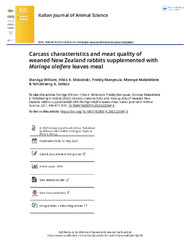| dc.contributor.author | William, Mankga | |
| dc.contributor.author | Mokoboki, Hilda K. | |
| dc.contributor.author | Manyeula, Freddy | |
| dc.contributor.author | Mabelebele, Monnye | |
| dc.contributor.author | Sebola, Nthabiseng A. | |
| dc.date.accessioned | 2025-07-30T07:21:51Z | |
| dc.date.available | 2025-07-30T07:21:51Z | |
| dc.date.issued | 2023-05-12 | |
| dc.identifier.citation | William, M., Mokoboki, H. K., Manyeula, F., Mabelebele, M., & Sebola, N. A. (2023). Carcass characteristics and meat quality of weaned New Zealand rabbits supplemented with Moringa oleifera leaves meal. Italian Journal of Animal Science, 22(1), 463-471. | en_US |
| dc.identifier.issn | 1828-051X | |
| dc.identifier.uri | https://www.tandfonline.com/doi/full/10.1080/1828051X.2023.2206416 | |
| dc.identifier.uri | https://hdl.handle.net/13049/796 | |
| dc.description.abstract | Moringa oleifera leaves (MOL) containing phytochemicals could be used to replace synthetic growth promoters to improve products quality in sustainable rabbit production. This study explores the supplementation of MOLM on carcass characteristics and meat quality of rabbits. A total of 64, 28 days-old male weaned New Zealand white rabbits (600 ± 8.58 g live weight) were randomly allocated to four diets in completely randomised design. The rabbits were reared on iso-energetics and isoproteic diets formulated by incorporating MOLM at 0, 5, 10, and 15% and were humanely slaughtered after 6 weeks. Heart weight increased linearly with MOLM levels (R2 = 0.50; p = 0.007) whereas slaughter (SLW), hot carcass (HCW), cold carcass (CCW), legs, head and kidneys weights were increased quadratically. Also, liver decreased quadratically (R2 = 0.41; p = 0.03) with MOLM levels. Fillet lightness (L*) (R2 = 0.21; p = 0.02), redness (a*) (R2 = 0.14; p = 0.04) and yellowness (b*) (R2 = 0.14; p= <0.0001) decrease whereas peak force increased (R2 = 0.63; p = 0.02) quadratically with MOLM levels. Leg muscle a* (R2 = 0.45; p = 0.0001) and cooking loss (R2 = 0.19; p = 0.0009) decreased linearly with MOLM levels. Only aroma (R2 = 0.04; p = 0.04), juiciness (R2 = 0.05; p = 0.04) and connective tissues (R2 = 0.03; p = 0.05) increased linearly with MOLM levels. In conclusion, MOLM did not adversely affect rabbit carcass characteristics and meat quality hence it can be recommended as a nutraceutical sources for sustainably rabbit production. | en_US |
| dc.language.iso | en | en_US |
| dc.publisher | Taylor and Francis Online | en_US |
| dc.relation.ispartofseries | Italian Journal of Animal Science;Vol. 22(1), 463-471. | |
| dc.subject | Carcass characteristics | en_US |
| dc.subject | Internal organs | en_US |
| dc.subject | Moringaolifera leave meal | en_US |
| dc.subject | Physico-chemical | en_US |
| dc.subject | Rabbit | en_US |
| dc.subject | Sensory evaluation | en_US |
| dc.title | Carcass characteristics and meat quality of weaned New Zealand rabbits supplemented with Moringa oleifera leaves meal | en_US |
| dc.type | Article | en_US |

